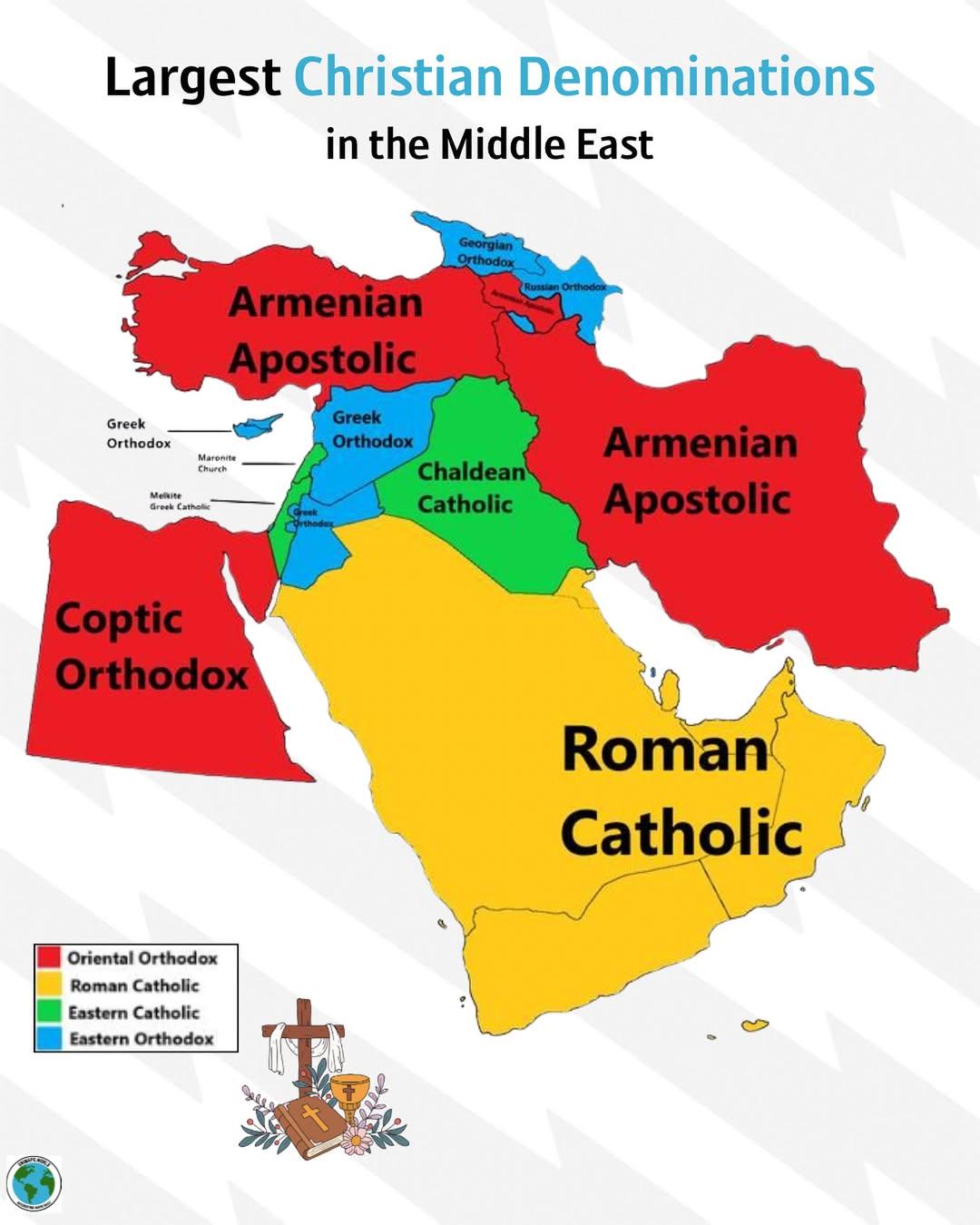Largest Christian Denominations in the Middle East Map


Alex Cartwright
Senior Cartographer & GIS Specialist
Alex Cartwright is a renowned cartographer and geographic information systems specialist with over 15 years of experience in spatial analysis and data...
Geographic Analysis
What This Map Shows
This map illustrates the distribution of the largest Christian denominations across the Middle East, a region historically rich in religious diversity. It highlights the predominant Christian groups present in various countries, offering a geographical perspective on their populations. By examining this visualization, we can understand not only where these communities reside but also the historical and cultural contexts that shape their presence today.
Deep Dive into Christian Denominations in the Middle East
Christianity in the Middle East is as ancient as the religion itself, with roots tracing back to the early followers of Jesus Christ. Today, the region is home to several significant Christian denominations, each with its unique history, beliefs, and cultural practices. The most prominent groups include the Greek Orthodox, Roman Catholic, Armenian Apostolic, Coptic Orthodox, and Protestant communities, among others.
Interestingly, the Greek Orthodox Church is one of the largest Christian denominations in the Middle East, particularly strong in countries like Lebanon and Syria. In Lebanon, the Greek Orthodox community plays a vital role in the country’s demographic landscape, making up a significant portion of the population. The complexities of Lebanon’s religious mosaic are further illustrated by the coexistence of various Christian sects alongside Muslim communities, each contributing to the nation’s rich cultural heritage.
The Coptic Orthodox Church, primarily found in Egypt, is another major denomination. The Copts claim to be the original Christians of the region, and their traditions and religious practices date back to the early centuries of Christianity. The Coptic community, despite facing challenges and persecution over the years, remains resilient, maintaining a vibrant culture that includes unique religious festivals and a rich liturgical life.
Another significant presence is the Armenian Apostolic Church, particularly in Armenia and among the Armenian diaspora in countries like Turkey and Lebanon. The Armenian Genocide in the early 20th century led to a dramatic diaspora, and today, the Armenian community continues to preserve its religious traditions and cultural identity.
Protestantism has also made inroads in the Middle East, particularly in countries like Syria, Lebanon, and Egypt. Various denominations, including Anglican, Evangelical, and Reformed churches, cater to a diverse audience and contribute to the region's ecumenical dialogue. Their presence is a testament to the adaptability and evolution of Christianity in response to changing social and political landscapes.
Regional Analysis
When we break down the map regionally, we see distinct patterns in the distribution of these denominations. For instance, in Egypt, the Coptic Orthodox Church dominates, making up about 10% of the population, which is substantial given the predominantly Muslim demographic. However, in Lebanon, the landscape is more varied, with a notable presence of Greek Orthodox Christians alongside a mix of other Christian sects. The delicate balance of power among religious groups in Lebanon is a fascinating case study in religious coexistence.
In Iraq, the Christian population has dramatically declined due to recent conflicts, with the Assyrian and Chaldean communities facing significant challenges. Once thriving, these communities now find themselves in a precarious position, contributing to a broader narrative of religious persecution in the region. In contrast, Jordan has become a refuge for many Christians fleeing unrest in neighboring countries, fostering a unique environment where various denominations coexist peacefully.
Interestingly, Cyprus also plays a pivotal role in the religious landscape of the Eastern Mediterranean. The island has a predominantly Greek Orthodox population, which is a reflection of its historical ties to Greece and the Byzantine Empire. The division of the island into the Greek Cypriot south and the Turkish Cypriot north adds another layer of complexity to the understanding of religious demographics in the region.
Significance and Impact
Understanding the distribution of Christian denominations in the Middle East is crucial for several reasons. Firstly, it sheds light on the historical contexts that have shaped these communities over centuries. Additionally, it highlights the importance of religious tolerance and coexistence in a region often characterized by conflict and division.
The future of Christianity in the Middle East is a topic of significant concern, especially given the ongoing geopolitical tensions. As religious minorities face persecution and displacement, there are implications for cultural heritage and the very fabric of society. The dwindling numbers of Christians in countries like Iraq and Syria raise questions about the sustainability of these communities in the long term.
Moreover, the map serves as a reminder of the need for dialogue and understanding among different religious groups. In a world increasingly defined by division, recognizing the shared history and contributions of Christian communities in the Middle East can pave the way for greater unity and cooperation.
In conclusion, this map not only provides a visual representation of the largest Christian denominations in the Middle East but also invites us to delve deeper into the rich tapestry of history, culture, and faith that defines this remarkable region.
Visualization Details
- Published
- August 17, 2025
- Views
- 142
Comments
Loading comments...